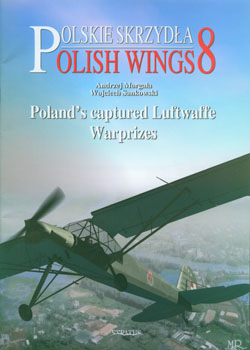
Polish Wings 8: Poland's Captured Luftwaffe Warprizes
By Chris Banyai-Riepl
| Author: Andrzej Morgala & Wojciech Sankowski | ISBN: 978-8-38945-081-4 |
| Publisher: Stratus, ©2008 | Binding: Softcover |
| Pages: 56 |
The Polish Wings series is a fascinating one, providing a glimpse into one of the more interesting small air forces during the Second World War. This latest edition in the series covers captured German aircraft, which opens up some excellent opportunities for the modeler. As seen on the cover, one of the main subjects of the book is the Fieseler Fi 156 Storch, but there are also quite a few other aircraft depicted, making this an excellent addition to either a small air forces library or general Luftwaffe one.
The book covers those aircraft taken over at the end of the Second World War, with attention given to the specific types as well as length of service. These aircraft are divided into roughly three categories: those military aircraft that were abandoned at fields across Poland, various utility aircraft such as transports and liaison types, and gliders, which included transport and assault gliders as well as the smaller sport and training gliders. For the most part, the combat aircraft were collected and scrapped, as the Soviet supply of fighter aircraft had Poland flying better types anyway. The breadth of aircraft types abandoned in Poland was vast, though, spanning everything from the Bf 109 on up to the He 177.
The utility aircraft were another story, though, as these found use in both military and civil roles. While most of the main transports were sent back to the Soviet Union, some found their way into Polish service, such as the Siebel Fh 104 and Si-204. The most numerous aircraft, though, was the Fieseler Fi 156 Storch, with a dozen of those returning to flight. Other types include the Bf 108, Bü 181, He 72, Fw 44, Kl 35, and Bü 131. Most of these carried civil registrations, although some carried military markings.
The vast majority of aircraft captured, though, fall into the glider category. Roughly 750 of these types were collected across the countryside, covering all types of gliders. The markings of these varied greatly, as there was no standardized application of national markings. Each glider therefore has an almost unique application of markings to cover up the former owner's insignia. Many of these gliders also carried names and/or artwork on them, presenting some very colorful aircraft.
This is a very interesting glimpse into early post-war Polish aviation, one which is fascinating both in the types of aircraft used and the markings employed. My thanks to Mushroom Model Publications for the review copy.
